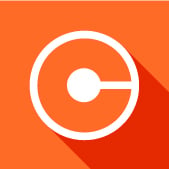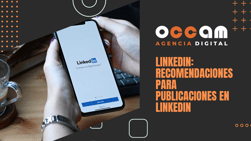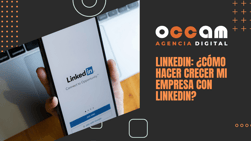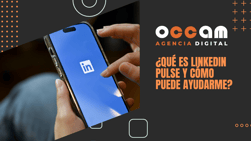LinkedIn's success: The world's largest professional network
Index Content
If there is one thing that characterises our society today, it is the infinite possibilities we have to communicate online, more specifically with the well-known Social Networks.
Nowadays we have an immense variety of Social Networks, and every day there are more and more of them and every day it is easier to access them and find the one we feel comfortable with according to what we want to express and show to other users.
For example:
The network of networks, enjoyable, for expressing yourself or spending time and based on friendships is Facebook.
If you want to keep up to date with what is happening every minute and express yourself in a few words, your network is Twitter.
If you have a company, a website and want to position your business on Google, you might be more interested in Google+.
If you're young (or not) and you're more into photography, don't hesitate, go for Instagram.
If your thing is life in images, Pinterest.
If you're more into improvisation, the moment and the spontaneous: Snapchat is your network.
But if you are a company, a freelancer, or simply want to be present in the professional environment, what you need is a social network oriented more towards commercial and professional relationships. If you are looking to network and do business with other companies and professionals, or to apply for positions in certain companies, then LinkedIn is the ideal social network.

We will briefly tell you about its curious history:
Its founder, Reid Hoffman, after finishing his studies was recommended to work at Apple where he stayed from 1994 to 1996, creating one of the first social platforms in the world, an online service that Apple called eWorld and which included email, daily headlines and a virtual community. However, eWorld was not very successful. Perhaps, in 1994, it was way ahead of its time and therefore also extremely expensive. It also had AOL as a rival, so in a matter of 2 years the Social Network collapsed.
In 1997, Hoffman and some friends decided to create his first company, SocialNet, with money from venture capitalists who saw an opportunity to create something truly innovative. Hoffman was looking for a meeting place for people with common interests. Unfortunately, without a proper outreach strategy, Hoffman did not achieve the minimum number of users he needed to keep his company going.
Later, friends invited him to work at their company, PayPal, where Hoffman learned how to interact with professionals from other industries or sectors, such as banking, software development, security, etc., and learned to recognise his weaknesses as a professional and to ask for help from more experienced people in those fields.
In 2002 Paypal was sold to eBay for $1.5 billion, which freed Hoffman to focus on creating his own social network, LinkedIn, so he gathered his former colleagues from both SocialNet and Paypal and set to work to develop his project as best he could.
LinkedIn was launched in May 2003, starting with 13 employees who invited a total of 112 users. By the end of that year, the platform developed the technology to allow users to upload their address books and thus generated the user-to-user marketing, the kind of online word-of-mouth that we are so familiar with today when we talk about social networking.
Over the course of 13 years, LinkedIn's success was brutal. Last year, LinkedIn Premium, a paid subscription-only service, made $149 million dollars and added a total of 433 million users. In Spain it has already surpassed 3 million users. LinkedIn was acquired by Microsoft for $26.2 billion in June last year, although Microsoft allowed it to maintain its initial style and culture.
-
what is LinkedIn?
LinkedIn is a professional Social Network that provides you with powerful tools with which you can do active Networking looking for companies and people you are interested in relating with, perfect for professional promotion and personal branding.
-
how does LinkedIn work?
The first step to start using LinkedIn is very similar to building a CV. You sign up, create your account and start filling in your professional details which are basically what you would put on your CV: professional qualifications, education, current and past jobs, skills, publications, etc. As you complete your information, LinkedIn starts to explore your relationships.
For example, if you indicate that you have held a job at a certain company for a certain period of time, LinkedIn will look among its members for employees of that company who have also been working there during the same period.
It is normal that even in small companies LinkedIn will find a lot of people and suggest them to you as potential contacts. Many people have regained a lot of lost contacts over time with this functionality and for this reason alone it has been worthwhile for them to register with this tool.
-
what's in it for you?
1 - Creating your own online CV is perhaps the functionality that is most associated with LinkedIn, although this does not mean that it is the most important. Having your own professional website is an important first step in creating and promoting your personal brand on the Internet. In fact, the traditional CV is in decline in the face of the commitment to this type of new media and more and more companies will consider the fact of not having a profile on LinkedIn a defect.
Think also that being present on LinkedIn is a guarantee that everyone has up-to-date information about you at all times and not a piece of paper you sent years ago.
And finally, having your LinkedIn profile gives you a lot of scope for small, but effective, professional promotion tricks such as, for example, including your LinkedIn profile in the footer of your email signatures. This will give you visibility and boost the growth of your network of contacts.
2 - Have a constantly updated contact book and recommendations. The fact that LinkedIn also functions as a network of contacts makes it an incomparable contact book.
Moreover, LinkedIn incorporates recommendations: you can ask your contacts for a recommendation and they can write a short summary of their professional opinion about you.
3 -LinkedIngroupsare a fantastic tool with endless possibilities: to keep up to date on the topics that interest you, to consult professional doubts with experts, to boost your personal brand and much more.





